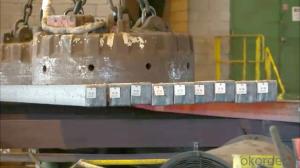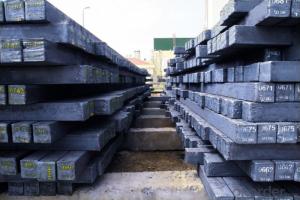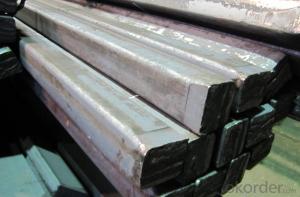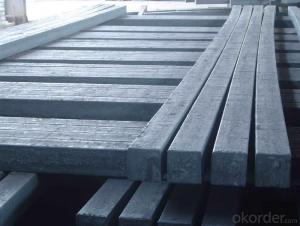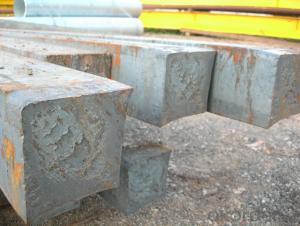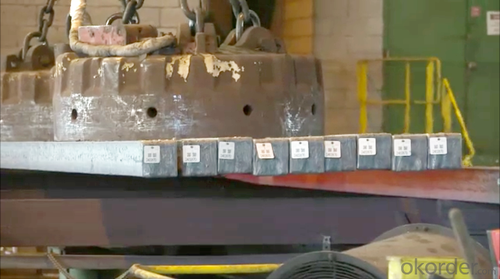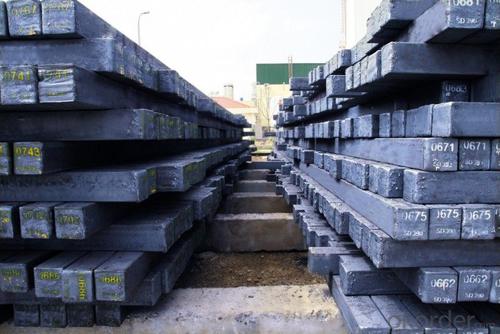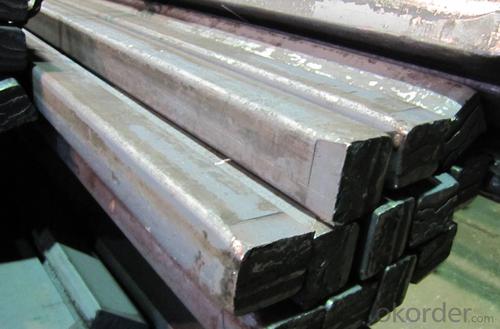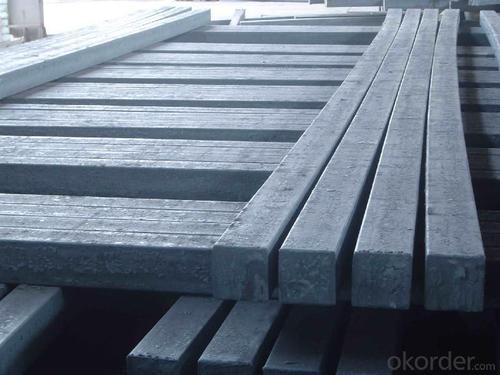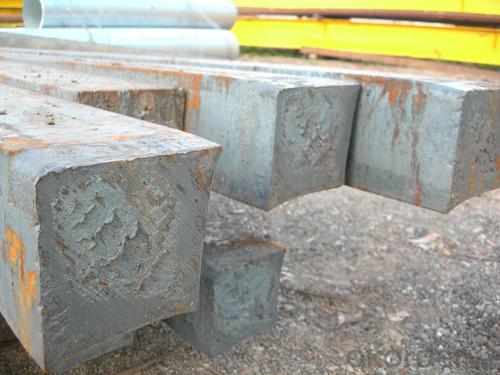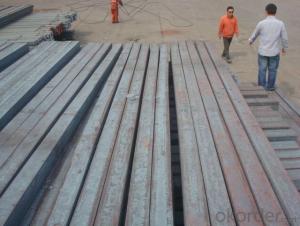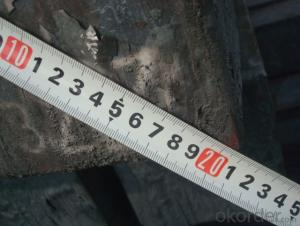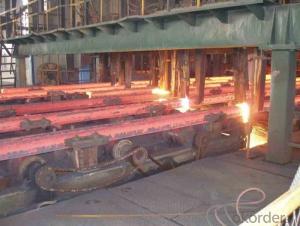Hot Rolled Steel Billet 3SP Standard 165mm
- Loading Port:
- Shanghai
- Payment Terms:
- TT OR LC
- Min Order Qty:
- 100 m.t.
- Supply Capability:
- 10000 m.t./month
OKorder Service Pledge
OKorder Financial Service
You Might Also Like
Structure of Hot Rolled Steel Billet 3SP Standard 165mm

Description of Hot Rolled Steel Billet 3SP Standard 165mm
Prepainted Rolled steel Coil is a kind of coated steel coil/sheet. With the cold rolled steel of different strength and thickness as substrate, it is produced through applying Al-Zn coat on both faces by hot dip process. In its coating, Al accounts for about 55%, Si 1.6%, while the remaining is Zn. Aluminum zinc coils enjoys both the physical protective feature and durability of Al and the electrochemical protective property of Zn. And its surface has bright silver color and regular embossed-like figure, which are highly decorative. RAL Scale Z35 Prepainted Rolled Steel Coil for Construction Roofing

Main Feature of Hot Rolled Steel Billet 3SP Standard 165mm
1.Corrosion resistance: It mainly depends on the zinc protection. When the zinc being worn,
2. Heat resistance: steel sheet has excellent heat resistance, can withstand high temperatures over 300 centigrade, and is similar with aluminized steel high temperature oxidation resistance. It often used in chimney pipes, ovens, fluorescent lighting device and the device cover.
3. Heat reflective: Galvanized steel plate heat-reflective high rate is twice as galvanized steel, often used to make insulation materials. RAL Scale Z35 Prepainted Rolled Steel Coil for Construction Roofing
Applications of Hot Rolled Steel Billet 3SP Standard 165mm
1. Construction and building: roofing; ventilating duct; handrail; partition panel;etc.
2. Electric appliance: refrigerator; washing machine; refrigerator; DVD;etc.
3.Transportation: oil tank; gas tank;road sign; etc.
4.Agriculture constructions :barn; etc.RAL Scale Z35 Prepainted Rolled Steel Coil for Construction Roofing
5.Others:vending machine; game machine; auto parts spare parts etc.
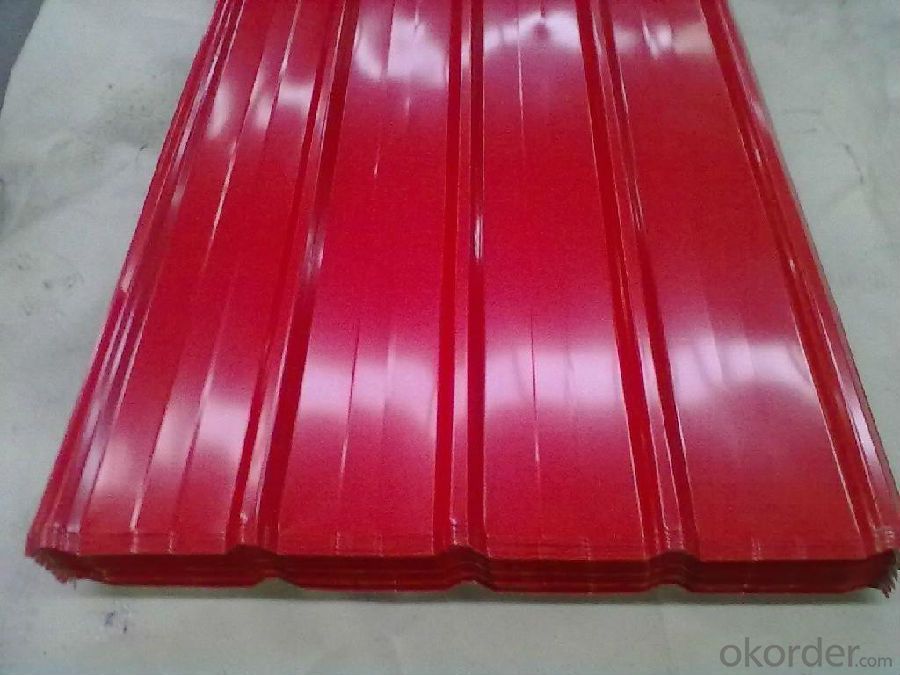
Specifications of Hot Rolled Steel Billet 3SP Standard 165mm
Product | Hot Rolled Steel Billet 3SP Standard 165mm |
Material Grade | SGCC / SGCH / DX51D+AZ, etc |
Thickness | 0.5-3.0mm |
Width | 700-1500mm |
Tolerance | Thickness: +/-0.02mm , Width:+/-2mm |
Zinc-coating | AZ30-150g/m2 |
Technique | Raw material: Hot rolled steel coil --> Cold rolled_>hot dipped galvalume |
Surface | Dried, Chromated, Unoiled,RAL Scale Z35 Prepainted Rolled Steel Coil for Construction Roofing |
Spangle | Regular spangle , small spangle, zero spangle |
ID | 508MM 610MM |
Coil weight | 25MT max |
Export package | Cardboard inner sleeves, Waterproof paper, galvanized steel covered and steel strip packed |
FAQ of Hot Rolled Steel Billet 3SP Standard 165mm
We have organized several common questions for our clients,may help you sincerely:
1. What is the minimum order quantity ?
Our MOQ is 100 mt for each size each specification. Usually we can offer discount if can buy large QTY once. RAL Scale Z35 Prepainted Rolled Steel Coil for Construction Roofing
2. How long can we receive the product after ordering?
Our general delivery time is 30 days after confirmation, but so some special orders, we have offer special delivery time
3. How to guarantee the quality of the products?
We have established the international advanced quality management system ,every link from raw material to final product we have strict quality test;We resolutely put an end to unqualified products flowing into the market. At the same time, we will provide necessary follow-up service assurance.
4. What is the payment?
We accept T/T, L/C
- Q: How are steel billets used in the production of conveyor systems?
- Steel billets are used in the production of conveyor systems as the raw material for manufacturing various components, such as frames, supports, rollers, and pulleys. These billets are typically shaped, cut, and machined into the required sizes and shapes to ensure the strength and durability of the conveyor system.
- Q: What are the potential applications of steel billets in the medical aftermarket?
- Steel billets have a wide range of potential applications in the medical aftermarket. One key application is in the manufacturing of surgical instruments. Steel billets can be used to produce high-quality, durable surgical instruments such as scalpels, forceps, scissors, and orthopedic implants. The strength and corrosion resistance of steel make it an ideal material for these critical medical tools. Additionally, steel billets can be used in the production of medical equipment and devices. For example, they can be used to manufacture components for X-ray machines, CT scanners, and MRI machines. Steel's excellent conductivity and high strength-to-weight ratio make it a suitable choice for these demanding applications. Furthermore, steel billets can be utilized in the production of medical furniture and fixtures. Steel is commonly used in the construction of hospital beds, examination tables, and cabinets due to its durability and ease of maintenance. Steel billets can provide the necessary raw material for the manufacturing of these essential medical items. Moreover, steel billets can also be employed in the fabrication of prosthetics and orthotics. These devices often require strong and lightweight materials to ensure proper functionality and comfort for patients. Steel billets can be processed into various shapes and sizes to create prosthetic limbs, braces, and other orthopedic devices. In conclusion, the potential applications of steel billets in the medical aftermarket are diverse and crucial. From surgical instruments to medical equipment, furniture, and prosthetics, steel billets offer the necessary strength, durability, and corrosion resistance to meet the demanding requirements of the medical industry.
- Q: How are steel billets used in the manufacturing of defense equipment?
- Steel billets are an essential component in the manufacturing of defense equipment due to their strength, durability, and versatility. Defense equipment, such as armored vehicles, tanks, and artillery, requires materials that can withstand extreme conditions and provide optimal protection. Steel billets, which are semi-finished steel products with a square or rectangular cross-section, serve as the raw material for various defense equipment components. These billets are typically melted and cast into specific shapes that meet the precise requirements of each equipment part. Once cast, steel billets are forged, heat-treated, and machined to create different defense equipment components like armor plates, gun barrels, missile casings, and vehicle frames. The high strength and impact resistance of steel billets make them suitable for these applications, ensuring the equipment can withstand ballistic impacts, blast forces, and other hostile conditions encountered in combat situations. Furthermore, steel billets can be easily welded, allowing for the assembly of complex structures and the integration of various components. This flexibility enables the creation of customized defense equipment designed to fulfill specific military needs. In addition to their mechanical properties, steel billets are also corrosion-resistant, which is crucial for defense equipment that may be exposed to harsh environmental conditions, including saltwater or extreme temperatures. This corrosion resistance ensures the longevity and reliability of the equipment, reducing maintenance requirements and costs. Overall, steel billets play a vital role in the manufacturing of defense equipment by providing the necessary strength, durability, and flexibility required for the equipment to perform effectively in combat situations. Their use ensures that defense forces have access to reliable and robust equipment that enhances their operational capabilities and protects the lives of military personnel.
- Q: What is the price range of steel billets?
- The price range of steel billets can vary depending on various factors such as the quality of the steel, market demand, and global steel prices. Generally, the price range of steel billets can range from $300 to $600 per metric ton. However, it is important to note that these prices are subject to fluctuations and can change over time. It is recommended to consult with steel suppliers or industry experts for the most accurate and up-to-date pricing information.
- Q: How do steel billet prices fluctuate in the market?
- Steel billet prices fluctuate in the market due to a variety of factors. One of the key factors is the demand and supply dynamics of the steel industry. When there is high demand for steel billets, prices tend to rise as suppliers have more leverage to set higher prices. Conversely, when demand is low, prices may decrease as suppliers compete for a smaller pool of buyers. Another important factor influencing steel billet prices is the cost of raw materials. Steel is primarily made from iron ore, coal, and scrap metal, and any fluctuations in the prices of these raw materials can directly impact the cost of producing steel billets. For example, if there is a shortage of iron ore, the price of steel billets may increase due to higher production costs. Additionally, market conditions and economic factors can also affect steel billet prices. Factors such as inflation, interest rates, and currency exchange rates can impact the overall cost of production and transportation, which in turn may influence the prices of steel billets. Furthermore, geopolitical events and trade policies can also play a role in price fluctuations. Tariffs, trade disputes, or changes in import/export regulations can disrupt the supply chain and impact the prices of steel billets. Overall, steel billet prices are subject to a complex interplay of factors, including demand and supply dynamics, raw material costs, market conditions, and geopolitical events. Traders, manufacturers, and investors closely monitor these factors to anticipate and respond to price fluctuations in the steel billet market.
- Q: How do steel billets contribute to the overall strength of a finished product?
- Steel billets contribute to the overall strength of a finished product by providing a solid and dense starting material. Due to their high carbon content and precise manufacturing process, steel billets offer superior mechanical properties, such as hardness and tensile strength. These attributes enable the billets to withstand heavy loads and resist deformation, ensuring that the final product possesses the necessary strength and durability.
- Q: 20 what is the difference between manganese silicon steel billet and Q235 billet?
- In brief, the ingredients are different and the uses are different.20 manganese silicon steel billet for high strength steel,Q235 billet is almost the most common steel, requiring the lowest.
- Q: What are the potential risks associated with steel billet production?
- There are several potential risks associated with steel billet production. One significant risk is the high temperature involved in the process, which can lead to burns and fire hazards if not properly managed. Additionally, the handling of heavy machinery and equipment poses a risk of accidents and injuries to workers. The use of chemicals and hazardous substances in the production process can also pose health risks if not handled safely. Another potential risk is the emission of pollutants and greenhouse gases during production, contributing to environmental concerns. It is crucial for steel billet producers to implement appropriate safety measures, train their employees, and adhere to environmental regulations to mitigate these risks.
- Q: What are the main factors affecting the hardness of steel billets?
- The hardness of steel billets is primarily influenced by several factors. Firstly, the carbon content plays a crucial role in determining the hardness of steel. Higher carbon content results in greater hardness, as carbon atoms occupy interstitial spaces within the iron crystal lattice, creating stronger bonds and increasing the material's resistance to deformation. Secondly, the presence of alloying elements has a significant impact on steel hardness. Alloying elements such as chromium, molybdenum, and vanadium form solid solutions with iron, altering its crystal structure and strengthening the material. These elements promote the formation of fine and homogeneous microstructures, leading to higher hardness. The heat treatment process is another crucial factor affecting steel billet hardness. Through processes like quenching and tempering, the steel undergoes controlled heating and rapid cooling, resulting in a transformation of its crystal structure. This process, known as martensitic transformation, increases the hardness of the steel by creating a high concentration of dislocations and reducing the grain size. Additionally, the cooling rate during solidification also affects the hardness of steel billets. Rapid cooling, such as in water quenching, promotes the formation of a fine microstructure and increases hardness. Slower cooling rates, on the other hand, allow for the growth of larger grains, resulting in reduced hardness. Lastly, the presence of impurities and non-metallic inclusions can negatively impact the hardness of steel billets. These impurities can disrupt the crystal lattice, reducing the material's strength and hardness. Therefore, the purity and cleanliness of the steel composition are crucial in achieving higher hardness levels. In conclusion, the hardness of steel billets is influenced by factors such as carbon content, alloying elements, heat treatment processes, cooling rate, and the presence of impurities. Understanding and controlling these factors are essential for achieving the desired hardness properties in steel billets.
- Q: What are the different types of steel billets?
- There exists a variety of steel billets, each possessing its own distinct attributes and applications. Among them, the most commonly encountered types are: 1. Carbon Steel Billets: Constructed from iron and carbon, these billets are widely employed due to their exceptional strength and durability. Consequently, they find utility in numerous sectors, including construction, automotive, and machinery manufacturing. 2. Alloy Steel Billets: By incorporating diverse alloying elements such as chromium, nickel, or manganese into carbon steel, alloy steel billets exhibit improved properties such as enhanced strength, hardness, and resistance to corrosion. Thus, they are frequently employed in industries necessitating high-performance materials, such as aerospace, oil and gas, and power generation. 3. Stainless Steel Billets: These billets are manufactured with a high chromium content, resulting in superior resistance to corrosion and oxidation. They are typically employed in applications where hygiene, durability, and aesthetic appearance are of utmost importance, such as food processing, medical equipment, and architectural structures. 4. Tool Steel Billets: Engineered to possess remarkable hardness, wear resistance, and heat resistance, tool steel billets are widely utilized in the fabrication of cutting tools, molds, and dies for various industries, including automotive, manufacturing, and construction. 5. Electrical Steel Billets: Comprised of low carbon steel with unique magnetic properties, electrical steel billets find application in the production of electrical equipment, such as transformers, motors, and generators. Their significance lies in their ability to minimize energy loss and exhibit high magnetic permeability. 6. High-speed Steel Billets: These billets are alloyed with elements such as tungsten, molybdenum, and cobalt, which enable them to retain their hardness and strength under high temperature conditions. They are extensively employed in the manufacture of cutting tools necessary for high-speed cutting operations, including drills, milling cutters, and taps. These examples represent only a fraction of the diverse range of steel billets available. The selection of a particular steel billet hinges upon the specific requirements of the application, such as strength, durability, corrosion resistance, or specialized properties essential for specific industries.
Send your message to us
Hot Rolled Steel Billet 3SP Standard 165mm
- Loading Port:
- Shanghai
- Payment Terms:
- TT OR LC
- Min Order Qty:
- 100 m.t.
- Supply Capability:
- 10000 m.t./month
OKorder Service Pledge
OKorder Financial Service
Similar products
Hot products
Hot Searches
Related keywords
